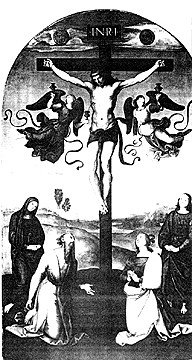|
|
The Crucifixion Theme |
|
 If you've found this site useful, we'd really appreciate a small donation to help with the hosting costs. Thanks! |
The drawing contains a number of traditional crucifixion motifs in a complex poetic interrelationship with the other main themes. The result gives rise to multiple interpretations typical of Picasso's best work of the 1930's.
The female on the left, identifiable as Marie-Thérèse Walter, is in a pose almost identical to that of Mary Magdalene in a number of Renaissance Crucifixions, including the Mond Altarpiece by Raphael. Picasso was a strict traditionalist, despite his amazing abilities for innovation.
The central figure alludes to Picasso. He has one clearly visible outstretched arm to the left and another outstretched arm, determining the Crucifixion pose, concealed in the island of light in the right hand figure's face. This 'flying arm' is a recurring feature in Picasso's poems of the 1930's. In the drawing the arm is severed at the black circle on the right. Severed arms such as this are a mysterious symbolic feature in many of Picasso's works, including Guernica. The spiral light source in the upper left corner of the drawing and the large black semi circle in the upper right corner relate to the Sun and Moon traditionally seen either side of the Cross in Renaissance Crucifixions. They represent duality and the complimentary opposites of light and dark, life and death and so on. This is also a common subject in Picasso's work in the 1930's. The ladder or pair of steps on which the central figure stands crucified is yet another traditional Renaissance Crucifixion motif. It also symbolises an alchemical ladder representing the stages of mystical initiation. The black almond shaped area In the central figure's abdomen would seem to symbolise a gaping wound, suggestive of the wound in Christ's side, which is always present in traditional Crucifixions. Out of the wound there appears to be an enormous flow of blood represented by the vertical black column of ink between the central and right hand figures. Picasso made the analogy between his blood and the ink in his drawings on more than one occasion. Rising out of the left hand figure's shoulder is a Tau Cross, which is associated with the Mithraic cult and alchemy. Behind the female on the right there are some crossed pen lines indicating another Cross. These two Crosses reinforce the idea that the two women in the drawing are also undergoing crucifixion. Either side of the ladder upon which the central figure appears crucified are the shadowy forms of two dark angels, which are again traditional Renaissance crucifixion motifs.
The central's figure's thrown back head suggests that he is at the moment of death or in a state of transfiguration analogous to death. Below his torso, concealed within the wash, there appears to be a half skull whose eye is the black oblong shape in the centre of the drawing. This relates to Golgotha, the place of the Skull, it is yet another traditional crucifixion motif. The drawing contains a number of other references to crucifixion linked to the stories of Parsifal, Oedipus, Odin and Frankenstein.
© Mark Harris 1996 Themes of the 1934 Drawing
Next Section: Symbolism in the 1934 Drawing |
|
|
|
     |
     |
|
|
© Mark Harris 1996 (content), Simon Banton 1996 (design) In general copyright of works by Pablo Picasso are the property of the heirs to the Pablo Picasso estate |
|


 The two females on either side of the central figure allude to the two women in Picasso's life in 1934, who in the context of the Crucifixion are characterised as the two thieves either side of Christ.
The two females on either side of the central figure allude to the two women in Picasso's life in 1934, who in the context of the Crucifixion are characterised as the two thieves either side of Christ.